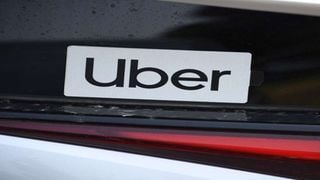
Uber driver almost robbed in Mathare.
| File | AFPEnterprise
Premium
Uber: A tale of broken promises, dreams
What you need to know:
- Kenyan Uber drivers are an unhappy lot. They say their investments have gone down the drain after the taxi hailing company slashed its fare prices.
It sounded like the perfect business partnership, one car owners and drivers would earn a decent living from. The company, Uber, promised competitive fare rates, easier access to customers and a handsome take away home after the company took its reasonable commission. Five years later, the early birds that invested in the taxi hailing business say what they have now is a raw deal.
David Muteru, the current Vice Chair, Digital Taxi Forum (DTF), which champions for the welfare of taxi drivers using digitised platforms, describes the current terms as inhumane.
According to him, they were lured into the business with what sounded like a good deal that would benefit both parties, but along the way, they were shortchanged, thanks to changes in the commission and introduction of painful rules without their participation.

David Muteru (left) of the Digital Taxi Association of Kenya with Central Police OCS Alphonse Ngundo during a past protest by Uber drivers.
“In 2015, Uber mostly attracted those with certain cars, for instance the Toyota Premio, Nissan Teana, Toyota Axio and the Toyota Fielder. Two years later, they introduced Uber Chap Chap — these small cars took away all our customers, leaving the early investors with no money to service the loans they took to buy the cars, as a result, most of them have had their cars repossessed,” he says.
Now a former Uber car owner and driver after his account and car were deactivated by the company for, he says, fighting for the improved welfare of the drivers, Mr Muteru is not a happy man.
The National Transport and Safety Authority (NTSA) estimates that 30,000 drivers work in the taxi-hailing sector. Though the total number listed is 65,000, most of the drivers cross list with different apps, hence the estimate.
And most of them are a troubled lot. They have loans to service, cars to service, yet, they say, the fare prices quoted by the company cannot meet these needs.
In February 2017, the then Principal Secretary, State Department of Transport, Irungu Nyakera, released a press statement addressing the 35 per cent price cut in fares by Uber that saw many of its drivers take to the streets to protest and call on the government to come to their aid.
The PS went ahead and held a stakeholders meeting that included the Presidential Delivery Unit, the Competition Authority of Kenya, NTSA and the Automobile Association of Kenya. They discussed workable proposals that Uber could undertake for the sake of the continuity and welfare of their business in Kenya.
He then tasked the Digital Taxi Association of Kenya (DTAK), led by Mr Muteru, to initiate dialogue with the State Department of Transport.He also urged Uber to audit its pricing mechanism.
In conclusion, the State Department recommended a raft of “bare minimum” collaterals for both parties to facilitate return to normalcy. To date, Mr Muteru says, they are yet to know what the said “bare minimums” were, and their grievances remain the same.

David Muteru, Vice Chairman, Digital Taxi Forum (left) and driver, Janet Sarah.
Fear for safety
But hefty commission cuts and reduced fare prices are just part of their grievances. They also fear for their safety.
While customers can access their information on the Uber app, they cannot access their customers’ profiles. This, they say, puts them at risk, because at times, they may be ferrying criminals. They also say that their drivers, especially the female ones, are sometimes subjected to sexual harassment.
In 2019, a female driver, Janet Sarah, had a male client offer her money to sleep with him. She refused, only for the client to send her the money anyway. On reaching his destination, the client tried to force her out of the car, and had a guard in the vicinity not come to her aid, he may have succeeded, she says.
She adds that she reported the matter to Uber, but has never received any feedback.
This one-sidedness in regard to access to profile data, she points out, is a big threat to them as they go about their job.
For Job Isaac, the flat rate applied to pricing is a disservice to them. He points out that thanks to traffic jams, impromptu road constructions and diversions, the time it takes to drive to the same destination today may not be the same tomorrow, but despite these considerations, the fare prices, once set by Uber, never change, forcing the driver to bear the cost.
“I could drive to pick a client from Jomo Kenyatta International Airport and drop him in town at a cost of Sh1,000, with light traffic, the journey takes at most an hour, but with the construction going on on Mombasa road, the trip can take up to three hours, yet the fare price will remain Sh1,000 – is this fair yet I end up using more fuel?” he posed.
He also feels that his safety as he goes about his job is not a priority to his employer, pointing out that while clients can access his profile, he cannot access theirs. He refers to an incident where a client threatened him with a gun to scare him off after he refused to pay him once he got to his destination.
“Should my car get stolen by a client, I have no sufficient information regarding him or her, making it difficult to get help from the police, also, Uber has no clear directions on how to go about such a scenario, we are like orphans with no rules, laws and regulations to fight for us,” he says.
Car swallowed by loans
Rhayan Kanyandong, the Chief Executive Officer of Digital Partners Society (DPS), says that he lost two cars to creditors after he failed to service his loans when business went to the cheaper Uber ChapChap.

Digital Taxi Forum CEO Rhayan Kanyandong'.
In May 2017, the association went to court to block introduction of UberGO a cheaper service, into the market, in an effort to protect its drivers, who were already grappling with a 35 per cent fare slash, but this too bore no fruit, even after being tossed between the Ministry of Transport to that of Information Communication and Technology and at times to that of Labour and Social Protection.
At last, they were directed to the Senate Committee on Delegated Legislation and that on Information Communication and Technology.
“The excuse was that the digital transport network was still relatively new in the country, therefore there were no clear rules and regulations to assist us,” Mr Kanyandong says.
Many of the those that signed up with Uber when it made an entry into the country, took bank loans to buy their vehicles, loans that Uber helped them secure. Currently, many have defaulted on their loans because they can no longer afford to pay, risking losing their cars.
“Helping us secure those loans was just a tactic to get many drivers, to expand their network at the expense of the car owners. I estimate about 80 per cent of vehicles being auctioned,” Mr Muteru says.
He is currently negotiating a loan restructuring deal with various banks to prevent the auctioning of 11 cars owned by former Uber drivers after they defaulted on loan payments.
But even owners of the small cars are not having it any easier, with a single newspaper advert listing the auctioning of 22 Suzuki Altos.
“They all belong to Uber drivers that could no longer service their loans. Business is hard even for them,” Mr Kanyadong points out.
In 2018, Stanbic Bank partnered with Uber and CMC Motors to offer loans for low cost vehicles worth Sh835,000 at an interest rate of 14 per cent. The loan was payable in three years.
Reports in a local daily show that in July this year, Stanbic Bank advertised the auctioning of 72 vehicles, among them 31 Suzuki Altos, common with the Uber ChapChap drivers.
Too expensive to maintain
A report by NTSA done earlier this year shows that the taxi hailing business is becoming too costly. According to the report, in a year, it costs a taxi owner Sh35,000 for annual vehicle insurance, another Sh16,000 for vehicle maintenance, Sh1,050 for the NTSA inspection fee while the PSV badge gulps another Sh1,050.
Besides this is another Sh16,000 for tyre replacement, Transport Network Company’s (TNC) inspection fee of Sh2,000 and daily budgets such as a car wash for no less than Sh200, Sh100 airtime, and Sh3,000 fuel.
Also to consider are miscellaneous costs such as lunch and water, which could cost about Sh200. Going by this estimate, the average Uber driver spends a whopping Sh3,704 a day to keep his business going. With slashed commissions, reduced fares and introduction of cheaper services, many drivers in this sector barely make anything, forcing them to work longer hours with little pay.
Speaking out about their challenges has come at a cost. In 2018, the current Chairman of the Digital Forum Platform, John Kimani, gathered his counterparts to protest the changing terms of their partnership with Uber, and for this, he claims, his account was deactivated, and his car can no longer be registered with the app.
He is hopeful that continued efforts by the Digital Taxi Forum and the Digital Partners Society to intervene on behalf of car owners and drivers will bear fruit. A joint meeting between the Senate Standing Committee on Labour and Social Welfare and the Ministry of Interior, Transport, Competition Authority of Kenya, NTSA and the Council of governor was held on December 4, last year.
A copy of the invitation letter from the Senate shows that matters to be discussed included the status of Uber and other digital hailing cabs in the country. The meeting was expected to come up with draft regulations on digital hailing cab applications in Kenya and a harmonised Memorandum of Understanding on the contractual relationship between the digital cab application companies and the drivers, the Ministry of Transport and the NTSA within 14 days after the meeting.
Though the taxi operators were not in the meeting, they believe this meeting is what led to the NTSA public forums in active digital cab zones early this year to come up with the draft Transport Network Companies rules. A public notice was published in February this year indicating the authority’s plan to get the public’s views on the Draft Digital Service Application Rules, 2020, to guide the sector’s operations in the country.
NTSA’s report to the Senate Committees on Delegated Legislature and their ICT counterparts showed how dire the situation was. They coined the phrase Transport Network Companies (TNCs) to refer to any entity or person who connects passengers or goods with transportation network drivers for pre-arranged or arranged transportation exclusively through use or operation of a transportation network.
The authority noted that the challenges on pricing, better pay and working conditions for drivers were not bound to Kenya only, but to other countries as well, including the US where in 2019, Uber and Lyft drivers protested the former’s decision to reduce per-mile pay in Los Angeles County and parts of Orange County by 25 per cent.
In Mumbai, India, in 2018, Ola and Uber drivers held a protest to demand minimum pay protection and an increase in the base passenger fare. In Melbourne Australia, E-hail drivers have protested low pay and poor working conditions.
The Authority’s draft TNC rules seek to deal with the imitation of commissions charged by setting out a mandatory minimum fare for TNCs as well as coming up with a mandatory minimum cost per kilometre. It will also work on formulating a pricing formula and set a cap on the commissions charged by the digital companies.
NTSA rule
Based on these drafts, NTSA introduced Rule 14 which provides that no transportation network company shall charge more than 15 per cent per trip. The companies are also prohibited from levying or charging a transport network vehicle owner and/or driver other charges, levies or fees over and above the commission.
The authority may also periodically revise the rate of commission upon market review. Owners and drivers however insist that the commission be capped at 8 per cent while the TNCs want the removal of the caps in their entirety.
Another matter raised by drivers is the breach of right to property and freedom of contract. Majority of them say that the company’s clauses, which most claim to have signed unknowingly, gives it absolute control of how to conduct the business, leaving them as spectators when it comes to decision-making, yet they own the cars.
To resolve this matter, NTSA’s draft rules provide that the driver/owners and the TNCs must have a binding agreement which clearly outlines the duties and responsibilities of the digital-hailing service operator to the owner and vice versa. The agreement must also clearly show the procedure and conditions for termination of the relationship and the validity of the agreement.
This proposal was however protested by the TNCs, saying it interfered with their right to run its business. The taxi digital app companies were also tasked to ensure the safety, protection and privacy of both the drivers and passengers.
When a driver is deactivated by the TNC, the company should provide NTSA with evidence of the driver’s misconduct. To foster discipline, a section of the draft regulations gives the NTSA authority to suspend the license of a TNC for failure of compliance with the rules and regulations.
When contacted by the Nation, Uber Head of Communications in East Africa, Lorraine Onduru, said that they take drivers’ welfare “very seriously”.
“Drivers are central to what we do at Uber and their safety and well-being is at the top of our minds. We constantly monitor feedback, driver economics and marketplace dynamics in each city to ensure that fares are correctly priced so that riders continue to take trips and drivers have access to more fare paying passengers,” she replied via email.
Though they have no qualms with the proposed regulations, Uber was jittery with the capping of commissions at 15 per cent.
“While Uber is supportive of positive regulation, we are particularly concerned about a clause proposing a 15 percent cap on commissions. If it comes into law, it would make it the most restrictive cap in the world, while adding unnecessary barriers of entry for Kenyans for whom ride sharing presents a platform for accessing flexible earnings,” Ms Onduru responded via email.
Uber also said that they had developed driving hour limits, a feature that prompts drivers to go offline for six hours straight after a total of 12 hours of driving time. Other key safety features that Uber said it had come up with include GPS tracking, working closely with the police to respond to urgent needs and introducing insurance to cover drivers and delivery patterns should they get involved in an accident while on the job.
Despite the assurances given by the ride-hailing platform, many of its drivers are still a worried lot and no one could explain it better than 33-year-old Douglas Ondieki, an auditor at a private firm in Nairobi who tried his luck in the Uber business. He bought a Honda Fit model late last year at Sh700,000. Nine months into the business and this is his verdict:
“My free advice to anyone wishing to join the business is simple. Invest your money elsewhere, that way, you can protect your money, you can try risk and venture into that business if you have another steady source of income, but wholly investing your money, worse, taking a loan to buy a car so that you can register with Uber is a no.”





